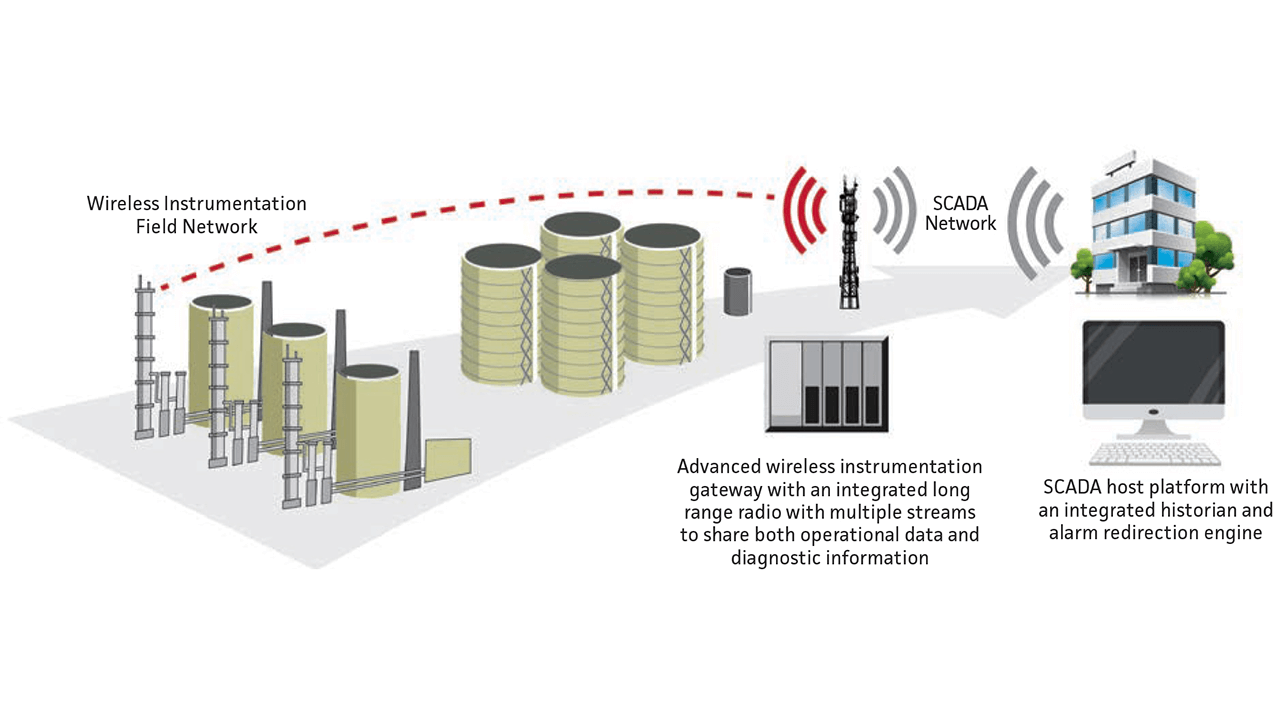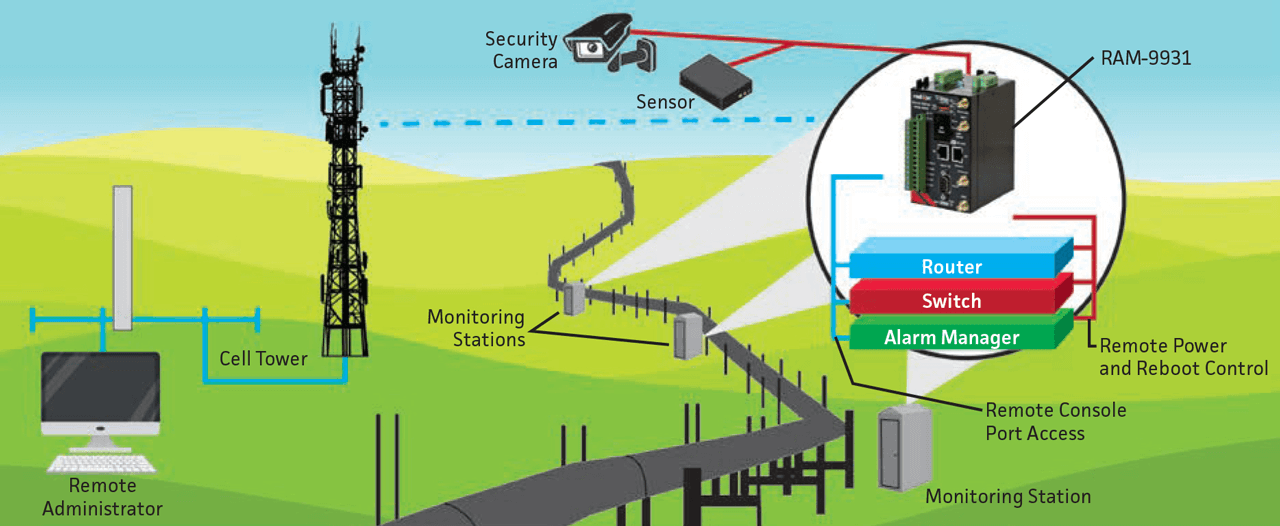TechnologyJanuary 28, 2019
Turn remote sites into smart remote sites

Cellular networking solutions are making it possible to connect, monitor and control remote assets. The goal is to build unmatched intelligence through a single cellular networking platform that provides an optimal solution to connect, monitor and control systems and processes and create smart remote sites.
Every business strives to protect revenue, and ensure uptime/availability for customers. Oil and gas, alternative energy, power and utilities all face challenges when working toward these goals. They must achieve seamless connectivity, regardless of territories, asset age and types of communication technology. Using cellular networking to build smart remote sites overcomes many infrastructure, financial and safety barriers.
Today’s energy and utility companies operate in competitive, closely scrutinized business environments. These organizations must adhere to stringent regulatory requirements to prevent downtime for customers. When equipment fails, the resulting downtime leads to immediate financial and safety consequences. As competitive forces grow and business demands intensify, companies can capitalize on the benefits of the IIoT to improve their processes and data assets.
Companies require more consistency, better visibility of networks, reduction of waste and loss, and increased compliance with regulatory requirements. Smart technology has the ability to connect all devices and control systems. It delivers the visibility to collect and analyze data from both new and legacy devices.
High-availability smart sites can:
- Minimize or eliminate unscheduled downtime
- Reduce time to repair
- Provide continuous operation, regardless of communication
- Increase visibility of equipment and sites
- Prevent unsafe conditions
- Comply with regulations

Equipment at remote sites connect to a cellular RTU, which has built-in edge processing capabilities.
Smart technology advantage
As the connected or “smart” technology trend advances, organizations also recognize the opportunity to outfit remote sites with these new applications. Bringing connectivity, control and monitoring capabilities to remote locations enables companies to find success in the IIoT environment.
To enable remote monitoring and control of data and equipment, energy and utility companies are integrating legacy equipment with IP networks. Cellular networking offers a cost-effective and intelligent solution. It can be leveraged across remote sites as a tool to reduce downtime and repair time, as well as to increase communication reliability and improve safety conditions. The level of connectivity afforded by cellular networking presents a host of new applications that help businesses run more smoothly and efficiently. It can also reduce the resources required to manage and run operations.
Monitoring remote assets
Companies are finding it more difficult than ever to maintain the integrity and operational efficiency of infrastructures. A single compromised point in an expansive energy or utility infrastructure can result in costly downtime and dissatisfied customers, and possibly lead to life-threatening situations. These challenges are heightened at remote sites where distance and visibility compound each issue.
Challenges to monitoring remote sites and remote equipment include, expansive geographic territory, aging industrial equipment, and out-of-date technology.
Cellular network performance
Below are statistics from a customer who converted from a traditional SCADA network that uses a polling/ response network to a cellular network. As demonstrated in the chart below, polling a site occurred approximately 10 times faster and emergency alarms were sent 95% faster using a cellular network. The architecture difference of a cellular network is significantly more scalable and can both poll and push data.
Expansive geography
Energy and utility companies commonly have large geographic footprints, ranging from multiple sites in a single city to a global network of locations. Long distances, harsh environmental conditions and limited field staff availability make these remote sites difficult to access regularly. Accessing critical information, such as equipment status and operational data, becomes even more time-consuming and costly as workforces stretch out to cover larger geographies. To maintain these expansive territories, companies must find new ways to bridge the distance.
Aging infrastructure

Alternative energy applications are ideally suited for remote monitoring technology.
Aging equipment creates significant challenges for businesses trying to implement new technology platforms. Older equipment was never designed to be remotely monitored in real-time and often only provides local communication ports.
While legacy equipment and assets may not be ready for high-speed IP networks, they still have significant life left in them. Most companies can’t afford to replace aging assets system wide, especially if the equipment is still useful. But alternative solutions, such as new communication, protocol conversion and control technologies, can keep aging infrastructures up and running smoothly.
Outdated communication technology
Companies often struggle to combine new technology with legacy systems and processes. Outdated communication systems, such as Modbus and distributed network protocols (DNP3), are typically serial-based and lack visibility into remote sites.
These communications infrastructures are slow and unable to integrate into new applications. Additionally, most legacy communication networks were not developed with built-in redundancies, and communication failures create a domino effect, which leads to stopped operations.
Power outage prevention
Organizations are already witnessing the consequences of not updating and maintaining networks. Consider a power substation located in a rural location, miles from the power company’s operations center. The substation provides electricity to nearby residences and a bustling industrial complex. The power company has reduced scheduled substation visits due to cost, a reduced workforce and resource constraints. Most of the equipment in the substation is decades old and using outdated communication technology.
The technology allows the operations center to identify when a power outage occurs, but it often cannot detect the cause or resolve the issue remotely. In an emergency situation, a
crew is required to travel to the substation and review all the equipment to try to find the issue. Uncovering the outage source and then repairing it could take several hours. All the while, the community is left without power.
Communication challenges put a lot at stake: downtime, blackouts and even catastrophic gas pipeline explosions. To prevent these disastrous consequences, companies must find technology solutions to monitor and control data at every location, no matter how remote.
Solution: cellular networking
To strengthen connectivity at remote sites in spite of these challenges, companies should consider adding more advanced monitoring, visibility and communication capabilities. Many oil and gas, alternative energy, power, utility, water and waste water companies are successfully integrating cellular networking as an intelligent, cost-effective solution.
If the electric utility had real-time, continuous connectivity to the substation, they could more quickly diagnose and address the issue. Such visibility would allow the operations center to proactively monitor equipment and notice any increased load demands on equipment. The company could take swift action by re-routing the electricity through another circuit. If the utility had the connectivity capabilities to implement demand response or distribution automation initiatives, outages in certain circumstances might be completely prevented.
Smart remote sites
By now, IIoT is beginning to take hold in every industry, including energy and utilities. Remote data monitoring is critical for effective IIoT implementation, where multiple devices across a system connect with each other.
To access data in hard-to-reach locations, companies across many industrial businesses have turned to cellular networking, which adds cellular connectivity to remote terminal units (RTUs). Together, RTUs and cellular networking have the power to connect diverse legacy equipment and turn remote sites into “smart” remote sites.
Cellular networking provides secure access to data in remote locations, leveraging nationwide cellular carrier networks. Reliable, easy connectivity to data enables organizations to monitor and control critical applications throughout their system, including aging equipment at remote sites. It eliminates costly visits to remote locations to update configurations or for real-time data collection. Also, cellular RTUs bridge the communication gap between legacy systems and modern real-time communication and control applications. This solution translates to large savings.
Energy and utility companies must find a suitable partner to successfully implement smart remote sites via cellular networking. Without the right vendor, an organization may find itself with a substandard program that does not withstand industry challenges. A reliable connectivity partner can align a company’s legacy systems with next generation technology.
Finding the right partner can significantly simplify the task of selecting and deploying a cellular networking solution.
Consider these important criteria when selecting a connectivity partner:
- Device management
- Security and regulatory standards
- Edge control
- Serial-to-IP conversion
- Cloud connectivity
- Purpose-built industrial products
- Rapid deployment
- Software development kit integration
Serial-to-IP conversion
Most remote sites contain legacy serial devices that communicate using Modbus, DNP3, or other protocols. To connect to modern SCADA or monitoring platforms, these protocols require a connection to an IP-based infrastructure. Serial-to-IP conversion is difficult due to speed and protocol differences. Cellular networking streamlines this process by connecting RTUs, programmable logic controllers (PLCs) and other human- machine interface (HMI) equipment. Cellular networking also configures the connected equipment to communicate at the appropriate speed and use the native protocol of the existing equipment.
Alternative solutions to serial-to-IP conversion do exist, but they require multiple gateways to communicate with the native protocol at the proper speed. They also require the extra step of converting the data to IP before finally communicating via cellular network.
Simplified assets
Building one hardened package with integrated routing, security and cellular technologies drastically simplifies smart remote site implementation. For example, cellular RTUs with native Modbus support can poll existing RTUs and PLCs. As a single asset, cellular RTUs provide real-time access to and from sensor-level data from pumps, valves, reclosers, transformers, capacitor banks, meters and more. Using multiple network devices—such as a cellular modem, Modbus gateway and security VPN client— is an option. But each device is costly to deploy and complicated to administer and maintain.
Cloud connectivity
An effective cellular networking solution uses cloud technology to enable connectivity across multiple devices—regardless of age, quality or distance. Cellular networking provides reliable, secure and scalable communication to leading IIoT cloud platforms. This solution allows organizations to easily establish communication and push data to select cloud platforms in minutes.
Purpose-built industrial products
Industries like oil and gas, alternative energy, power, utilities, water and waste water demand technology that can withstand challenging conditions. For instance, an electric utility’s on-site devices need to tolerate high electromagnetic interference (EMI). A cellular networking solution that is purpose-built for these industrial environments ensures device control and data collection continue even if communication fails.
Edge control
Cellular networking solutions often use edge control, which processes data as near to the data source as possible: at the edge of the network. Shifting control to the network’s edge enhances operational reliability. It also reduces costs by decreasing the amount of transmitted data.
SCADA control at headquarters
Data is often collected and transmitted from remote sites and sent all the way to the headquarters to process the data is. If a change is required, a signal is sent back. If the network is unresponsive, all control stops.
Rapid deployment
When transitioning to cellular network connectivity, equipment downtime equals lost revenue. A system that rapidly deploys and connects within minutes minimizes lost time and lost revenue.
Device management
When a cellular network connects thousands of devices, it is critical to incorporate a device management platform. A central dashboard gives users visibility into the health and connectivity statistics of each device.
Cellular network: control at edge
Equipment at remote sites connect to a cellular RTU, which has built-in edge processing capabilities. So if the network is unresponsive, the cellular RTU can still perform all control activities. Common alternative monitoring approaches include:
Satellite communication
Satellite communication, with a dish mounted onsite, is a common choice for incorporating connectivity at remote sites. It provides coverage for large areas and requires only a single-service provider. However, satellite service is charged on a per megabyte data rate, which becomes expensive. Additionally, satellite communication lacks reliability in harsh environmental conditions and heavily forested areas. Dishes need clear line-of-sight to the sky. Snow, rain and wind can make satellite communication systems inoperable.
Fixed wireless networks
Fixed wireless networks are common in environments where a company has many devices within line-of-sight of each other. The fixed wireless network aggregates the devices and uses licensed or unlicensed frequencies, 900MHz or 2.4MHz. This solution allows for data transfer without incremental fees. But any devices out of range of the fixed wireless network will be expensive or impossible to connect.
If a radio on the network fails, the company will typically need to send a climber, electrician and IT expert to diagnose the issue and repair the radio, network, cable and power supply. Towers are also susceptible to lightning strikes, which can take out the entire network.
Leased-line or dial-up networks
Connectivity through leased-line or dial-up networks over copper-based lines are common in electrical utilities. Many cities already have phone lines running on traditional twisted copper, and utilities try to leverage this platform. However, leased-line or dial-up networks are slow and unreliable.
In fact, most telephone companies are trying to eliminate copper-based networks due to the high cost of maintenance and the mass adoption of high-speed IP networks. The price of leased-line networks, even with their slow dial-up connections, are skyrocketing. Also, buried copper lines are easily damaged by agriculture, utility and industrial projects that dig into the ground.
Solution: cellular networking
Satellite communication, fixed wireless networks and leased-line or dial-up networks can service remote sites. But risks often outweigh benefits. Cellular networking solution offers advanced reliability, cost efficiency, and connectivity anywhere, anytime.
Reliable cellular networking
Smart remote sites connected by cellular networking deliver advanced access to existing RTUs, PLCs, HMIs and process control equipment. They use an easy-to-configure solution integrated into a single, cellular automation device.
Even when working across multiple locations, cellular networking delivers the power to:
- Minimize or eliminate downtime
- Reduce time to repair
- Ensure continuous operation
- Increase visibility of equipment
- Improve safety conditions
- Comply with regulatory requirements
Reliable, rugged, secure design
RAM RTU technology combines a built-in Modbus gateway and state-of-the-art firewall with full router functionality and 4G LTE cellular connectivity. This design provides a compact, industrially hardened device. It is easily implemented and does not disturb the existing environment. Customers who need connectivity with a low cost of deployment benefit from the Sixnet® series, which provides access to common IIoT platforms.
Simplify implementation
Additionally, application customization is optional via an integrated SDK. RAMQTT reduces deployment and configuration complexities involved with IIoT integrations. It simplifies implementation with pre- configured profiles for AT&T M2X, Amazon AWSTM IoT, Cumulocity, Microsoft Azure, Nokia Impact and Telenor Connexion. Red Lion’s MQTT client allows users to be up and running in less than two minutes per device.

